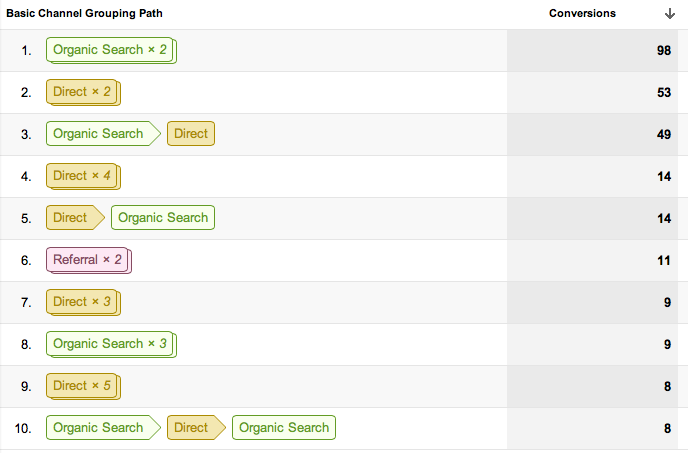Exploring What Data Is Google Analytics Goals Unable to Track
Exploring What Data Is Google Analytics Goals Unable to Track
Blog Article
Discover the Limitations of Google Analytics Goals: Introducing the Data Types That Remain Untrackable
As organizations increasingly depend on data-driven decision-making, recognizing the limitations of tools like Google Analytics ends up being extremely important. While Google Analytics Goals offer important understandings into customer communications, there exist data kinds that avoid monitoring, presenting obstacles to a comprehensive understanding of customer habits.
Insufficient User Journey Tracking
Incomplete individual journey monitoring within Google Analytics can prevent the capability to accurately evaluate user actions. When the customer trip is not totally tracked, there are voids in the information that avoid a comprehensive understanding of exactly how individuals connect with a site. This absence of understanding can bring about missed out on opportunities for optimization and renovations to the customer experience.
One common problem with insufficient user trip monitoring is the lack of ability to see the complete course that customers take previously completing an objective or leaving the website. Without this details, it is testing to recognize where customers might be encountering challenges or rubbing factors that stop them from converting. Furthermore, insufficient tracking can obscure the impact of particular marketing efforts or internet site changes on user behavior.
To address this restriction, it is crucial to set up appropriate monitoring devices within Google Analytics to capture the whole user trip. This might entail setting up occasion tracking, objective funnels, or making use of tools like Google Tag Supervisor to ensure that no vital communications go unrecorded. By getting a detailed view of the user trip, web site owners can make more educated decisions to enhance customer engagement and drive conversions.
Attribution Difficulties
Navigating via acknowledgment obstacles in Google Analytics needs a complete understanding of how various touchpoints contribute to the general conversion procedure. Acknowledgment obstacles arise from the complexity of contemporary consumer trips, where customers communicate with several networks prior to transforming.
One usual acknowledgment obstacle is the trouble in connecting conversions to the appropriate source, particularly in instances where individuals interact with numerous channels prior to converting. Furthermore, cross-device tracking postures one more acknowledgment challenge, as customers commonly switch in between gadgets throughout their journey, making it testing to track their communications effortlessly.
Offline Conversions
Given the obstacles related to attributing conversions properly in online networks, the dimension of offline conversions offers a considerable opportunity for online marketers looking for a much more detailed understanding of their customers' journey. Offline conversions refer to activities that consumers take in the physical globe, such as making acquisitions in brick-and-mortar stores or over the phone, going to occasions, or involving with published products - what data is google analytics goals unable to track. These conversions are essential for services that operate both online and offline, as they provide beneficial insights right into the effectiveness of advertising projects across numerous touchpoints
Tracking offline conversions typically presented a significant obstacle for marketing experts, as it was testing to link these actions back to details More Help online interactions precisely. With innovations in modern technology, such as the assimilation of CRM systems, unique identifiers, and discount coupon codes, services can now bridge the space in between online and offline data to obtain a more all natural view of client behavior. By properly determining offline conversions, marketing professionals can optimize their strategies, allot resources extra efficiently, and eventually enhance the total client experience.
Cross-Device Monitoring
Cross-device tracking plays an important role in recognizing the interconnected nature of consumers' electronic interactions throughout multiple gadgets. In today's omnichannel world, where customers seamlessly switch over in between smart devices, desktop computers, check my site and tablet computers, tracking their actions across these tools is crucial for marketing experts to acquire a thorough view of their customer trip.

In addition, privacy issues and guidelines such as GDPR and CCPA have further challenging cross-device monitoring. With individuals requiring more control over their data and raised restrictions on tracking modern technologies, marketing professionals have to discover ingenious and privacy-compliant means to connect user communications across devices.
Dynamic Web Content Interaction
Recognizing user engagement with dynamic content is pivotal in optimizing digital marketing techniques for enhanced audience communication. Dynamic web content describes web site elements that alter based upon customer habits, preferences, or various other elements, providing a customized experience. Tracking user interactions with dynamic material positions challenges for conventional analytics tools like Google Analytics.
While Google Analytics can track basic communications like clicks and web page views, it may battle to record more nuanced engagements within vibrant material. what data is google analytics goals unable to track. Metrics such as time spent on specific vibrant components, float actions, or interactions within pop-ups are often not easily measurable using basic tracking approaches. This constraint prevents marketers' ability to completely understand how customers are engaging with dynamic web content and tailor their methods accordingly

Final Thought
To conclude, Google Analytics goals have restrictions in tracking insufficient customer trips, connecting conversions precisely, catching offline conversions, tracking cross-device communications, and measuring dynamic material involvement. These restrictions highlight the importance of checking out extra tracking techniques and tools to acquire a much more thorough understanding of customer habits and conversions past what Google Analytics can provide.
While Google Analytics Goals deal important insights into customer interactions, there exist data kinds that elude monitoring, presenting difficulties to an extensive understanding of customer habits.Insufficient customer journey monitoring within Google Analytics can prevent the capacity to properly examine individual habits. When the user journey is not totally tracked, there are voids in the data that prevent an extensive understanding of how users connect with an internet site.One usual problem with incomplete customer trip tracking is the failure to see the full course that individuals take previously completing an objective or leaving the site. By gaining a comprehensive sight of the individual journey, internet site owners can make more enlightened choices to boost customer interaction and drive conversions.
Report this page